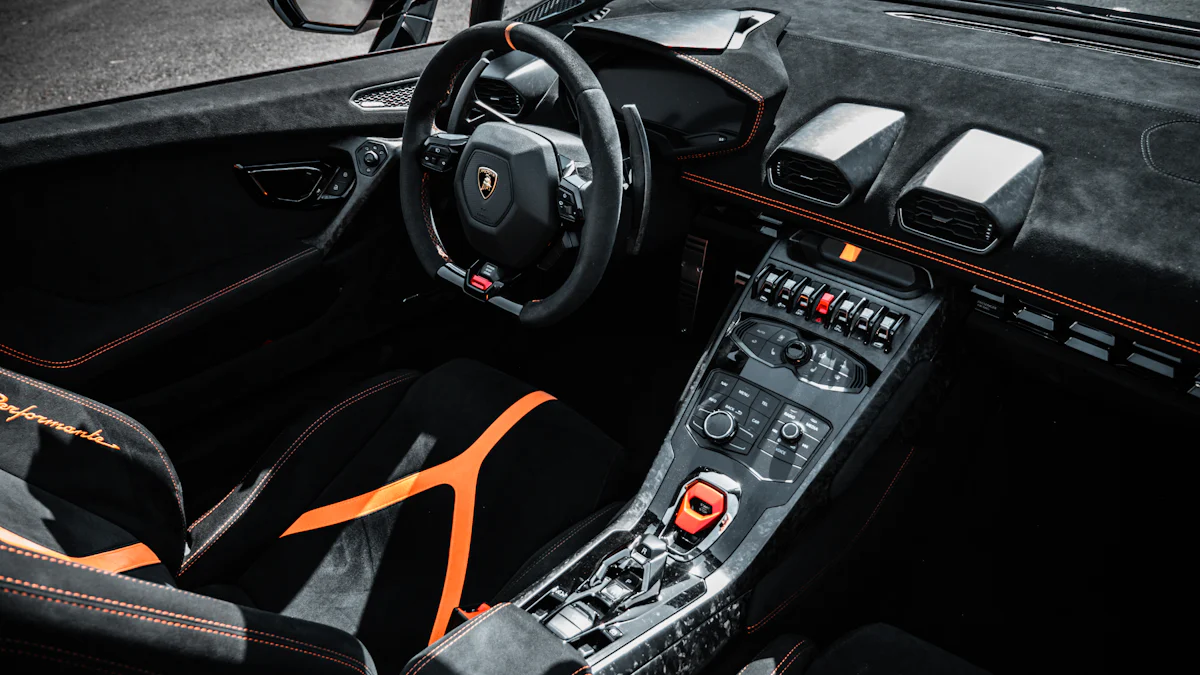El compuesto forjado de Lamborghini y el futuro del automóvil

Lamborghini’s Forged Composite represents a revolutionary leap in automotive materials. This advanced Lamborghini Forged Composite combines short carbon fibers with resin, creating a lightweight yet incredibly strong structure. You can see its impact in supercars, where it reduces weight by 40%, enhances acceleration, and improves handling. Unlike traditional carbon fiber, Lamborghini Forged Composite offers precise manufacturing tolerances of ±0.1 mm, ensuring exceptional performance. Lamborghini’s ACSL facility pioneered this innovation, producing components like carbon fiber suspension arms. By mastering the entire design-to-production process, Lamborghini has set a new standard in automotive engineering, blending performance with sustainability.
Principales conclusiones
Lamborghini’s Forged Composite is a game-changing material that combines short carbon fibers with resin, resulting in a lightweight yet incredibly strong structure that enhances vehicle performance.
This innovative material reduces weight by up to 40%, leading to faster acceleration, improved handling, and better fuel efficiency, making it ideal for high-performance supercars.
Forged Composite offers superior strength and flexibility compared to traditional materials like steel and aluminum, ensuring durability while effectively absorbing impacts.
The streamlined manufacturing process of Forged Composite not only cuts production costs but also allows for complex shapes, paving the way for broader applications in the automotive industry.
As the automotive sector shifts towards sustainability, Lamborghini’s Forged Composite supports reduced emissions and improved energy efficiency, making it a vital component for future electric vehicles.
What is Lamborghini’s Forged Composite?

How It Is Made
The creation of Lamborghini’s Forged Composite involves a precise and efficient process. You start by mixing short, chopped carbon fibers with resin. This mixture is then placed into a heated mold. The mold compresses the material, shaping it into complex forms. After just a few minutes, the finished part is removed, ready for use. Unlike traditional carbon fiber, this method eliminates the need for an autoclave, speeding up production. Lamborghini’s RADICARBON technology uses 1- to 2-inch-long cut fibers, which intertwine densely during molding. This results in a material with superior strength and stiffness compared to conventional materials.
The unique composition of Lamborghini’s Forged Composite plays a critical role in its performance. Short carbon fibers provide strength and flexibility, while the resin acts as a binding matrix. Together, they create a material that is lightweight yet incredibly strong. This combination ensures structural integrity, making it ideal for high-performance applications like supercars.
Key Properties and Benefits
Lamborghini’s Forged Composite offers several advantages that set it apart from traditional materials. Its lightweight nature significantly reduces the weight of components, enhancing vehicle performance. The material’s exceptional strength-to-weight ratio makes it stronger than steel or aluminum. This allows you to enjoy faster acceleration and improved handling in vehicles using this technology.
Heat and impact resistance are other standout features. Forged Composite efficiently absorbs and disperses energy, making it highly resistant to impacts. This property enhances safety, especially in automotive applications. Additionally, the material withstands high temperatures, ensuring durability under extreme conditions.
Cost-effectiveness is another benefit. Unlike traditional carbon fiber, Lamborghini’s Forged Composite uses a streamlined manufacturing process. This reduces production time and costs, making it more scalable for various applications. By combining performance, durability, and affordability, Lamborghini’s Forged Composite represents a breakthrough in automotive engineering.
How Lamborghini’s Forged Composite Compares to Traditional Materials
Steel and Aluminum
Weight and performance differences
When comparing Lamborghini’s Forged Composite to steel and aluminum, the weight difference becomes immediately clear. Steel, while strong, is heavy and adds significant mass to a vehicle. Aluminum, though lighter than steel, still cannot match the ultra-lightweight properties of Lamborghini’s Forged Composite. By reducing the weight of components, this advanced material allows you to experience faster acceleration and sharper handling. The lighter structure also improves fuel efficiency, making it a game-changer for performance-focused vehicles.
Strength and flexibility comparison
Steel offers excellent strength but lacks flexibility, which can lead to brittleness under extreme stress. Aluminum provides more flexibility but sacrifices some strength in the process. Lamborghini’s Forged Composite strikes a perfect balance. Its unique composition of short carbon fibers and resin creates a material that is both incredibly strong and flexible. This combination ensures durability while maintaining the ability to absorb impacts effectively. You get a material that outperforms steel and aluminum in both strength and adaptability.
Traditional Carbon Fiber
Differences in structure and manufacturing
Traditional carbon fiber relies on a layered structure, where sheets of woven fibers are molded and bonded together. This process, while effective, is time-consuming and labor-intensive. Lamborghini’s Forged Composite, on the other hand, uses a forging process. Millions of tiny carbon fibers are pressed together with resin under extreme heat and pressure. This method creates a compact, structurally sound material that is not only lightweight but also visually striking. The forging process eliminates the need for layering, speeding up production and allowing for more complex shapes.
The tightly interwoven fibers in Lamborghini’s Forged Composite enhance its strength and durability. Unlike traditional carbon fiber, which can delaminate under stress, the forged material remains intact even under immense forces. This makes it ideal for high-performance applications where reliability is critical.
Cost and scalability advantages
Traditional carbon fiber manufacturing is expensive and difficult to scale due to its labor-intensive nature. Lamborghini’s Forged Composite addresses these challenges with its streamlined production process. By eliminating the need for manual layering and autoclave curing, it reduces production costs significantly. This makes it more accessible for broader applications in the automotive industry. You benefit from a material that combines high performance with cost-effectiveness, paving the way for its use in future vehicles.
Applications of Lamborghini’s Forged Composite in Supercars

Lamborghini Models Featuring Forged Composite
Sesto Elemento
The Sesto Elemento stands as a prime example of Lamborghini’s innovative use of Forged Composite. This supercar incorporates the material in critical components such as the monocoque, suspension, transmission shaft, front subframe, crash boxes, and exhaust system. These applications significantly reduce the car’s weight, enhancing its agility and performance. The Sesto Elemento weighs just 999 kg, a remarkable achievement that contributes to a 20% reduction in fuel consumption and CO2 emissions compared to heavier models.
Huracán Performante
The Huracán Performante also showcases the potential of Lamborghini’s Forged Composite. This model uses the material in its aerodynamic components, including the active aerodynamics system (ALA). The lightweight properties of Forged Composite allow the car to achieve faster acceleration and improved handling. By integrating this advanced material, Lamborghini has pushed the boundaries of performance and design in the Huracán Performante.
Lamborghini Model | Component Made from Forged Composite |
|---|---|
Sesto Elemento | Monocoque, suspension, transmission shaft, front subframe, crash boxes, exhaust system |
Aventador Replacement (LB744) | Front structure |
Performance and Design Enhancements
Improved Aerodynamics and Speed
Lamborghini’s Forged Composite plays a vital role in enhancing aerodynamics and speed. For instance, the Sesto Elemento features body panels that are one-third the thickness of traditional carbon fiber panels. Despite their reduced thickness, these panels maintain the required rigidity through integrated stiffeners inspired by aerospace engineering. The material’s lightweight nature also improves the car’s power-to-weight ratio, enabling faster acceleration. The Aventador replacement (LB744) benefits from a front structure made of Forged Composite, which is 20% lighter than its aluminum predecessor. This reduction in weight contributes to a 25% increase in torsional stiffness, ensuring better handling and stability.
Característica | Descripción |
|---|---|
Thickness | The skin of the Sesto Elemento is one-third the thickness of previous CFRP body panels. |
Rigidity | Achieves required rigidity through integrated stiffeners inspired by Boeing 787. |
Reducción de peso | Achieved a 40% reduction in weight and emissions. |
Aceleración | Reduced 0 to 100 km/h time to 2.5 seconds without a new powertrain. |
Enhanced Fuel Efficiency and Sustainability
By reducing weight, Lamborghini’s Forged Composite improves fuel efficiency and sustainability. The Sesto Elemento demonstrates this with a 20% reduction in fuel consumption and emissions. Similarly, the LB744 chassis for the Aventador replacement uses Forged Composite in its front structure, making it 20% lighter than aluminum. This weight reduction not only enhances performance but also aligns with Lamborghini’s commitment to sustainability.
Lamborghini’s Forged Composite represents a leap forward in combining performance with environmental responsibility. Its applications in supercars like the Sesto Elemento and Huracán Performante highlight its transformative potential.
Broader Implications of Lamborghini’s Forged Composite for the Automotive Industry
Lightweighting and Sustainability
Reducing emissions and improving fuel economy
Lamborghini’s Forged Composite plays a crucial role in reducing vehicle weight, which directly impacts emissions and fuel economy. Lightweight materials require less energy to move a vehicle forward. This leads to:
Lower fuel consumption, saving costs for drivers.
Reduced emissions, contributing to environmental protection.
Enhanced energy efficiency, aligning with global sustainability goals.
Vehicle weight reduction has become a cornerstone of modern automotive strategies. Automakers worldwide recognize its importance in achieving energy efficiency and meeting stricter emission standards. By integrating lightweight materials like Lamborghini’s Forged Composite, you can enjoy improved performance while supporting a greener future.
Potential applications in electric vehicles (EVs)
The rise of EVs has created new opportunities for Lamborghini’s Forged Composite. Lightweight materials are essential for EVs, as they:
Improve energy efficiency by reducing the load on batteries.
Enhance handling and driving dynamics.
Increase crashworthiness, ensuring better occupant protection.
Industry | Potential Applications |
|---|---|
Automotive | Chassis, body panels, suspension components, interior trims |
By incorporating Lamborghini’s Forged Composite into EV designs, manufacturers can create vehicles that are not only efficient but also safer and more durable.
Challenges and Future Developments
Scalability and cost considerations
Scaling up the production of Lamborghini’s Forged Composite remains a challenge. While the material offers cost advantages over traditional carbon fiber, its advanced manufacturing process requires specialized equipment and expertise. Automakers must invest in infrastructure to make this material more accessible. You may see costs decrease as production methods improve and demand increases.
Adoption by other automakers
Lamborghini has set a benchmark with its innovative use of Forged Composite. However, widespread adoption by other automakers will depend on overcoming scalability issues and demonstrating the material’s versatility. As more companies explore lightweighting solutions, Lamborghini’s Forged Composite could inspire a new era of sustainable automotive design.
Lamborghini’s Forged Composite has the potential to revolutionize the industry. Its lightweight properties, combined with its strength and cost-effectiveness, make it a valuable asset for both traditional and electric vehicles.
Lamborghini Forged Composite has redefined automotive design by combining lightweight properties with unmatched strength. You can see its impact in vehicles like the Sesto Elemento, which achieved a 40% weight reduction and faster acceleration without a new powertrain. This material also makes the LB744 chassis 20% lighter than aluminum while increasing torsional stiffness by 25%. Lamborghini’s innovation sets a benchmark for sustainable manufacturing, reducing emissions and enabling complex designs. By leading advancements in materials, Lamborghini paves the way for efficient, high-performance vehicles that align with future sustainability goals.
PREGUNTAS FRECUENTES
What makes Lamborghini’s Forged Composite different from traditional carbon fiber?
Lamborghini’s Forged Composite uses short carbon fibers mixed with resin, unlike traditional carbon fiber’s woven sheets. This method creates a stronger, lighter material with faster production times. You also benefit from its ability to form complex shapes, which traditional carbon fiber struggles to achieve.
Can Forged Composite be used in electric vehicles (EVs)?
Yes, Forged Composite is ideal for EVs. Its lightweight properties reduce battery strain, improving energy efficiency. You also gain better handling and crash protection. These features make it a valuable material for the growing EV market.
How does Forged Composite improve vehicle performance?
Forged Composite reduces weight, enhancing acceleration and handling. Its strength-to-weight ratio surpasses steel and aluminum, ensuring durability. You also experience improved aerodynamics and fuel efficiency, making it perfect for high-performance vehicles.
Is Lamborghini’s Forged Composite environmentally friendly?
Yes, it supports sustainability by reducing vehicle weight, which lowers fuel consumption and emissions. Its streamlined production process also uses less energy compared to traditional carbon fiber, making it a greener choice for automotive manufacturing.
Will other automakers adopt Forged Composite?
Many automakers are exploring lightweight materials like Forged Composite. Its cost-effectiveness and performance benefits make it attractive. As production scales and costs drop, you can expect wider adoption across the industry.
